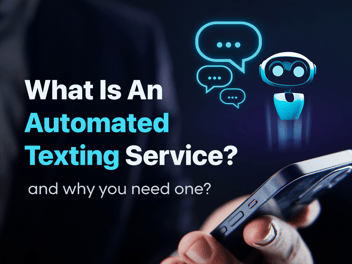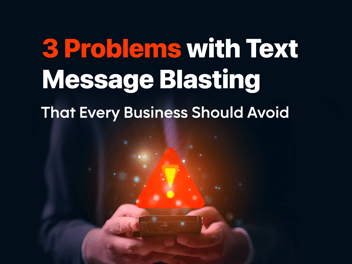Planning Your SMS Marketing Strategy

Today, it's not just about tossing messages into the digital abyss – there's a fine line between engaging your audience and becoming an unwelcome guest in their inbox. When annoyance can outweigh curiosity, an effective SMS marketing strategy is crucial.
Think about it: 47% of customers admit to feeling annoyed by SMS marketing. Clearly, there's more to this game than meets the eye.
So, read on to learn how to plan an effective SMS marketing strategy. The kind that doesn't just get your message across but does it in a way that your audience values.
Let's get started.
Choosing the Right Platforms
With the shift in business practices caused by the pandemic, SMS marketing platforms have become an essential channel for reaching audiences directly through mobile phones.
These serve as tools that enable businesses to send SMS messages to their contact lists, facilitating effective communication with potential and existing customers.
SMS marketing software offers a range of features such as automation, contact management, segmentation, two-way messaging, scheduled texts, personalization, and even chatbots. These capabilities streamline sending messages at scale to deliver while enhancing the overall customer experience.
When choosing the right platform for your SMS marketing campaign, several quality options are available. Here are the top SMS marketing platforms today:
Meera
Our top pick engages new leads within seconds and automatically schedules meetings with your sales reps. Meera utilizes cutting-edge AI texting technology to initiate human-like conversations that lead to meaningful sales interactions, all while avoiding spammy text messages.
With its conversational AI capabilities, Meera comprehends and responds to leads, bolstering your connect rate by an impressive 45%.
Furthermore, Meera's robust system doubles as an AI text messaging platform for business operations, automating up to 80% of your sales team's administrative tasks while maintaining human-like interactions on a larger scale.
Twilio
Renowned as a comprehensive customer engagement platform, Twilio simplifies cross-channel communication through SMS, MMS, and WhatsApp messaging.
Twilio uses SMS APIs to develop customized workflows, incorporating unique personalization and one-to-one text messaging capabilities. While Twilio excels at offering a wide array of communication solutions, it requires a degree of coding to set up initial SMS campaigns.
SimpleTexting
If user-friendliness is a priority, SimpleTexting shines as an excellent choice. Its intuitive interface enables users to swiftly create and launch campaigns.
Particularly suitable for mass text message campaigns rather than one-on-one conversations, SimpleTexting supports bulk SMS, scheduling, auto-replies, segmentation, and two-way messaging.
While it boasts ease of use, it might not be the most intricate SMS marketing provider for more complex and scalable applications.
Klaviyo
Ideal for those seeking versatile functionality, Klaviyo supports two-way conversations, automation, MMS, A/B testing, and smart sending. Smart sending is a standout feature that ensures messages are delivered to the right customers at optimal times.
Whether preventing overexposure to multiple campaigns in a day or ensuring critical alerts reach the appropriate recipients, Klaviyo's smart sending feature delivers tailored communication.
TextMagic
When time is of the essence, TextMagic stands out with its streamlined setup process, guiding users from sign-up to sending in minutes. While it may not boast the most intricate features among its competitors, TextMagic balances functionality and usability.
TextMagic provides ample tools for businesses to send notifications, reminders, confirmations, alerts, and SMS marketing campaigns like:
- API integration
- Two-way texting
- Scheduling
- MMS capabilities
By assessing your business goals and specific requirements, you can select the platform that best aligns with your strategy to effectively reach and engage your target audience.
Identifying Target Audience and Goals
Pinpointing your target audience and defining clear goals are foundational steps that significantly impact the success of your campaign. By meticulously identifying your audience and establishing specific goals, you pave the way for crafting customized messages that resonate and deliver results.
The significance of recognizing your target audience cannot be understated. Understanding your audience's demographics, preferences, behaviors, and pain points allows you to tailor your messages accordingly.
This level of personalization goes beyond a one-size-fits-all approach and enables you to connect on a more meaningful level. It's a digital handshake saying, "We understand you, and we're here to provide value in a way that speaks to you."
Note that several key factors come into play when identifying your target audience.
- Demographics: Understand their age, gender, location, income level, and other relevant demographic data.
- Psychographics: Dive into their interests, hobbies, lifestyle, values, and behaviors. This helps you connect on a more personal level.
- Pain Points: What challenges do they face? Knowing this allows you to position your product or service as a solution.
- Communication Preferences: How do they prefer to receive information? Some prefer short and concise texts, while others are open to more detailed messages.
- Purchase Behavior: Understand their buying patterns and preferences. This can guide you in offering relevant products or deals.
Let's talk about goals. Setting specific goals for your SMS campaign provides a clear sense of direction and a metric for measuring success. Generic goals like "increasing sales" are vague and don't provide a roadmap for action.
Instead, establish goals like "Increase website traffic by 20% through SMS-driven promotions in the next quarter" or "Generate 500 new leads for our upcoming webinar within two weeks." When you define your audience and set clear objectives, you can create campaigns that drive results.
Creating a Message Structure and Content Ideas
A well-structured message ensures your content is clear, concise, and compelling. Here are the components of an SMS message structure:
- Introduction: Start with a friendly greeting or a catchy hook to capture attention.
- Body: Deliver the main message concisely. Incorporate conversational and branded messaging that aligns with your unique tone of voice. This fosters a relatable connection with recipients.
- Call to Action (CTA): Clearly state what action you want the recipient to take, whether it's clicking a link, making a purchase, or visiting your store.
- Signature: End with a personal touch, such as a sender's name or a brand sign-off.
Conversational messaging is crucial. Avoid sounding robotic or overly formal. Instead, use language that mirrors how people naturally speak. This approach creates a more approachable and relatable vibe, encouraging recipients to engage.
Meera's SMS marketing platform integrates conversational AI to provide an automated solution to generate leads without losing the human approach.
On the other hand, branded messaging ensures consistency. Your tone of voice, vocabulary, and style should align with your brand identity. Whether aiming for humor, professionalism, or something in between, the messaging should reinforce your brand image.
Content ideas are also vital for keeping your SMS marketing fresh and engaging. Consider using personalized auto-responder messages for new subscribers, giving them a warm welcome and a special offer.
Experiment with A/B testing to fine-tune your messaging strategy. For instance, try different CTAs or message lengths to see what resonates best with your audience.
Incorporating these elements into your message structure will help you create an impactful SMS marketing campaign that resonates with your audience and drives meaningful engagement.
Setting Up Contact Lists
Another fundamental step when planning your SMS marketing strategy is setting up quality subscribers.
Quality is key. Focus on gathering subscribers who have a genuine interest in your offerings. An engaged audience is more likely to respond positively to your messages.
Acquiring subscribers involves a few strategies. Utilize opt-in requirements, where individuals voluntarily sign up to receive your messages. These can be integrated into your website, social media profiles, and physical store locations.
You can also implement gamified pop-ups that offer value to users who subscribe. Also, consider the convenience of "Text to Join," where potential subscribers can text a keyword to a designated number to subscribe.
Remember, the quality of your subscriber list directly influences the effectiveness of your SMS campaign. It's about nurturing a community that finds value in your messages.
Establishing Opt-In Requirements and Security Protocols
Maintaining trust and permission are paramount in SMS marketing. That's where opt-in requirements and security protocols come into play.
Building a genuinely interested subscriber base is essential. Collect opt-ins from customers through various channels, ensuring they explicitly agree to receive your messages. This can be done via website sign-up forms, social media campaigns, or in-store prompts.
Explicit confirmation is also crucial. Before sending any text messages, ensure that subscribers have confirmed their opt-in status. This safeguards against sending unwanted messages and maintains a positive user experience. Keep up-to-date on messaging regulations so that you can set expectations and ensure compliance.
By implementing these measures, you create a foundation of trust and respect with your subscribers, enhancing the overall success of your SMS marketing efforts.
Scheduling Messages for Maximum Effectiveness
Timing is everything when it comes to SMS marketing campaigns. Strategically scheduling messages can significantly impact engagement and response rates.
For best results, send messages during active hours (typically 8 AM to 5 PM) when recipients are more likely to be available and attentive. Avoid late nights and early mornings, as they might disrupt customers' privacy and attention.
Leverage automation platforms like Meera to optimize your scheduling. These platforms analyze recipient behavior and engagement patterns, automatically determining the best time for each message based on individual preferences.
Furthermore, be selective about the content you send via SMS. Reserve this channel for the most exciting, urgent, or relevant information. This approach maintains a sense of anticipation and ensures customers remain engaged and eager to open your messages.
Maximize your SMS marketing campaign by carefully planning schedules and content and delivering meaningful and effective messages.
Implementing an Effective SMS Campaign
In the same way that a conductor builds an incredible score, a well-executed SMS campaign involves strategic planning, engaging content, and attentive analysis. Let's delve into how to create and fine-tune a winning SMS marketing strategy.
Crafting Engaging Messages and Offers
The balance between conveying essential information and maintaining the recipient's interest is crucial. Incorporating your brand's tone of voice ensures consistency and familiarity, but don't be afraid to infuse a touch of creativity or humor to stand out.
Branding is more than just a logo – it's about creating a distinctive personality for your business that resonates with your audience. Your tone of voice should also stay true to your brand. People appreciate engaging messages that mirror real-life conversations, and this approach often leads to higher engagement rates.
Triggered welcome and personalized auto-responder messages are invaluable tools for nurturing customer engagement. These messages make your subscribers feel valued and acknowledged right from the start.
Imagine receiving a warm welcome message after subscribing to a service – it sets a positive tone and builds anticipation for what's to come.
Adjust discount amounts, as even a slight adjustment can impact conversion rates. Test the waters with SMS vs. MMS messages, assessing how multimedia content influences engagement. And if time sensitivity aligns with your brand, don't hesitate to use urgent language to encourage immediate action.
Short and interactive messages have a unique charm. Limiting your message to around 200 characters forces you to distill your content to its essence. These concise messages are easy to digest and encourage recipients to act quickly.
Adding GIFs to your messages is another way to infuse playfulness and catch the eye. A GIF can convey emotion or demonstrate a product, making it a powerful addition to your messaging arsenal.
Testing Your Messages to Optimize Performance
Imagine your marketing strategy as a puzzle. A/B testing is like trying different pieces to see which ones fit best. It's a strategy that empowers you to fine-tune your approach and maximize the performance of your SMS marketing campaigns.
A/B testing is, in essence, a controlled experiment. By isolating specific variables in your messages and comparing the outcomes, you gain actionable insights into what works best for your audience.
You can test different elements like copy – whether it's your offer's wording or your CTA's clarity. For example, "Shop Now" might perform better than "Learn More."
SMS marketing is dynamic, and A/B testing is your compass to navigate it effectively.
Monitoring Results and Making Adjustments
Keeping a watchful eye on campaign results isn't just a best practice – it's a necessity. When you monitor results, you get a real-time snapshot of your campaign's performance, which gives you the insight needed to make informed decisions.
SMS marketing software solutions offer comprehensive reporting features to view your campaign metrics. Open rates tell you how well your messages are capturing attention. Click-through rates provide insight into engagement levels, and conversion rates reveal the true impact of your messages.
By delving into this data, you can identify what's working and what needs adjustment. Remember, your audience isn't static, and neither should your approach.
Leveraging Automation for Efficiency
Automation streamlines various aspects of your SMS campaign. You can instantly acknowledge incoming messages and inquiries using the auto-reply feature, showing your audience that their engagement matters.
Scheduling messages ahead of time aligns with your predefined marketing plans, ensuring consistent communication even when you're not actively overseeing the campaign.
Several automated messages play crucial roles:
- Welcome Campaign: Send a warm greeting and a special offer to new subscribers.
- Abandoned Cart Message: Remind customers about their unpurchased items and offer incentives.
- Browse Abandonment Message: Engage customers who browsed products but didn't buy.
- Win-Back Campaign or Inventory Alerts: Re-engage inactive customers or notify them about restocked items.
These automated messages enhance engagement, recover potential sales, and maintain a proactive connection with your audience.
Efficiency isn't about cutting corners – it's about optimizing your efforts to provide value seamlessly. Automation empowers you to easily manage a dynamic SMS campaign, ensuring your messages hit the right notes at the right times.
Analyzing Your SMS Campaign’s Performance
Often overlooked, text messaging is the undisputed marketing hero. You must, however, analyze performance in detail to maximize your marketing efforts.
Key metrics paint a vivid picture of your campaign's impact. Conversion rates unveil the real-world impact of your messages, showcasing how many recipients took the desired action. Open rates provide insights into the effectiveness of your subject lines, while unsubscribe rates offer a window into audience satisfaction.
All the while, getting customer feedback can provide valuable insights for refining your strategy without losing sight of personal connections and efforts to improve. In fact, 56% of customers say their perception of a company has changed when it responds to a review.
Various tools and platforms facilitate the tracking and analysis process. SMS marketing software offers dashboards that aggregate essential metrics, while analytics platforms dive deeper into data interpretation.
Analyzing SMS campaign performance is not just about gathering numbers but also about understanding trends and identifying patterns.
Reviewing and interpreting campaign data is where the magic happens. It's about recognizing what worked and what could be enhanced. Did a specific offer resonate more? Did a certain time of day yield better engagement?
Analyzing the performance of your campaign is a strategic necessity for shaping your future endeavors.
Wrapping Up
A well-crafted SMS strategy is like a choreographed routine that leaves an indelible mark.
By meticulously planning each step, from identifying your target audience and goals to crafting engaging messages, leveraging automation, and analyzing performance, you set the stage for a captivating performance that resonates with your audience.
So, as you plan your SMS marketing campaign, remember that every message sent is an opportunity to create value, build relationships, and leave a lasting impact.
With the right strategy, your SMS campaign can rock the modern marketing world, helping your business succeed.
A programmer by trade, Nick Saraev is a freelance writer and entrepreneur with a penchant for helping people achieve their business goals. He's been featured on Popular Mechanics & and Apple News and has founded several successful companies in e-commerce, marketing, and artificial intelligence. When he's not working on his latest project, you can find him hiking or painting.


.png?width=512&height=512&name=guru%20(1).png)

.png?width=199&height=109&name=salesforce-logo1-removebg-preview%20(1).png)


.webp?width=716&height=569&name=banner-img%20(1).webp)



